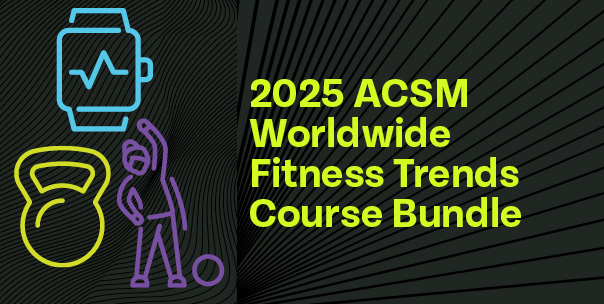


The results of the annual ACSM’s Health & Fitness Journal® worldwide survey guide fitness industry decision-makers with data collected from thousands of researchers and practitioners.
The 2025 survey polled professionals on 45 possible trends, across seven categories, on a scale of 1 (least likely to be a trend) to 10 (most likely to be a trend).
This article from ACSM’s Health & Fitness Journal® highlights the rise of digital health technologies and summarizes both the challenges and opportunities associated with the use of technologies and helps exercise professionals to identify which technologies may be suitable for integration into their practice/business.


As you look around your home, you may spot devices like smartphones, tablets, smart TVs

Recent public health guidelines emphasize the importance of high-intensity interval training (HIIT) as an effective

Wearable technology takes #1 spot Technology applications in the fitness industry continue to build momentum


Dementia is one of the leading causes of disability and mortality worldwide, and modifiable lifestyle
Wearable technology continues as the #1 trend in the 2025 survey, nearly consistent with previous survey results since 2016 (#3 for 2018 and #2 for 2021). The field of wearable technology is constantly advancing and allows real-time self-monitoring and feedback from devices such as fitness trackers, smartwatches, heart rate monitors, and GPS tracking devices. These devices can provide information such as physical activity, health markers, sedentary behaviors, sleep, and even stress. Wearable activity trackers can support healthy lifestyle behavior change through goal setting, personalized coaching, or connecting with apps to provide actionable insights.
Mobile exercise apps continue to move up the list (#7 in 2024 and #20 in 2023) and seem to be a more important trend among exercise professionals with more experience. In 2023, there were 850 million fitness app downloads by nearly 370 million users. The upward trajectory of mobile exercise apps could be fueled by their complimentary nature with wearable technology (the #1 trend).
Development and Pilot Testing of a Telehealth Weight Loss Program | by Hales and colleagues, published in the Translational Journal of the American College of Sports Medicine
The History of Exercise Equipment: From Sticks and Stones to Apps and Phones| by Parrott and colleagues, published in ACSM’s Health & Fitness Journal®
Fitness Watches and Nutrition Apps: Behavioral Benefits and Emerging Concerns | by Scheid and Lupien, published in ACSM’s Health & Fitness Journal®
Ally with Your Fitness App: Help Others Maintain Motivation with the WHY-WAY-DO Framework | by Segar, published in ACSM’s Health & Fitness Journal®
The development of fitness programs for older adults holds its place as the #3 trend. Regular physical activity for this population remains a critical strategy for maintaining overall health, preventing chronic diseases, improving quality of life, and the promotion of independent living.
Exercise for weight loss remains consistent as the #4 trend. Global rates of obesity have doubled among adults, with approximately 1 in 8 adults categorized as having obesity. Further, obesity rates among children and adolescents have nearly quadrupled in the past 30 years. While the benefits of exercise are positive regardless of weight status, regular exercise should be included as a part of a multicomponent strategy for the long-term maintenance of weight loss.
After falling to #17 in the 2024 survey, traditional strength training moves back up the trends list to #5. Traditional strength training, a key tenet of ACSM’s exercise guidelines, incorporates equipment such as barbells, dumbbells, and kettlebells focusing on proper movement and lifting technique to improve or maintain muscular fitness. The 2018 Physical Activity Guidelines for Americans recommend that adults complete at least two days per week of strength training, across all major muscle groups.
The Do It Right Series appears in every other issue of ACSM’s Health & Fitness Journal®. The series on executing proper technique is written and demonstrated by Peter Ronai, M.S., FACSM, ACSM-CEP, ACSM-EP, EIM III, CSCS
Rising to #6 on the trends list, HIIT has been a consistent top 10 trend since 2018. Its stability is likely due to its effectiveness as a training modality across demographics and among varying health statuses (e.g., cardiometabolic disease and cancer). HIIT involves repeated short bouts of near maximal, high-intensity aerobic efforts followed by active or passive rest periods that allow sufficient recovery to repeat the same working effort.
Data driven training technology was added in 2024 and appears as the #7 trend for 2025. Data-driven training technology can help clients understand the physiological responses to an exercise stimulus in real-time. This type of training allows individualized coaching and instruction, even in a group setting where there may be various fitness levels. Exercise professionals also may leverage biofeedback (i.e., sleep, and heart rate variability) as critical components of training and recovery.
Exercise for mental health remains the #8 trend after being added in 2024. This trend focuses on exercise programming designed to improve aspects of mental health, like reducing feelings of anxiety, stress, and depression.
This training modality typically encompasses strength training to improve balance, coordination, functional movement, and endurance that reflect activities of daily living. This trend is particularly critical for exercise professionals working with older adult and clinical populations to establish exercise behaviors that support improved quality of life across the lifespan.
This trend has moved up to the #10 spot for 2025. Health and wellness coaches utilize principles of behavioral science to promote health and lifestyle medicine programs. ACSM’s partnership with WellCoaches® provides exercise professionals with access to evidence-based coaching tools to facilitate growth and promote change amongst exercising individuals.

This course bundle is a convenient, all-in-one resource covering the topics of the top 10 2025 fitness trends.
6510 Telecom Dr.
Suite 200
Indianapolis, IN 46278
317-637-9200
317-634-7817
ACSM’s National Center hours are 8 a.m. to 5 p.m. ET Monday through Friday.
© ACSM. All Rights Reserved.